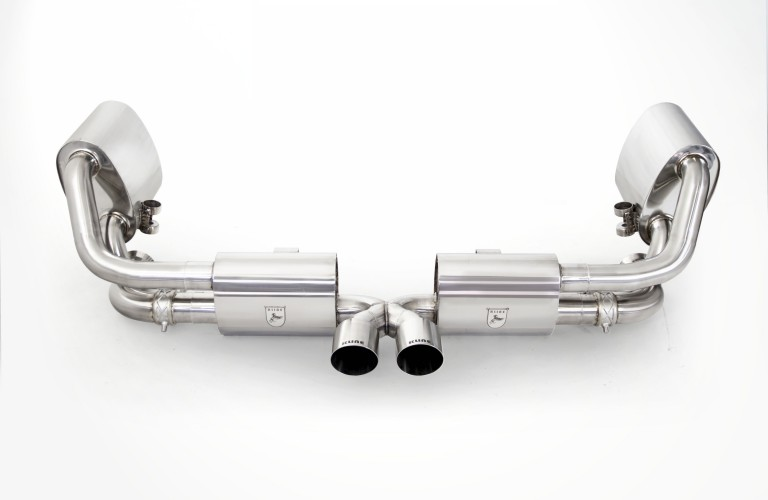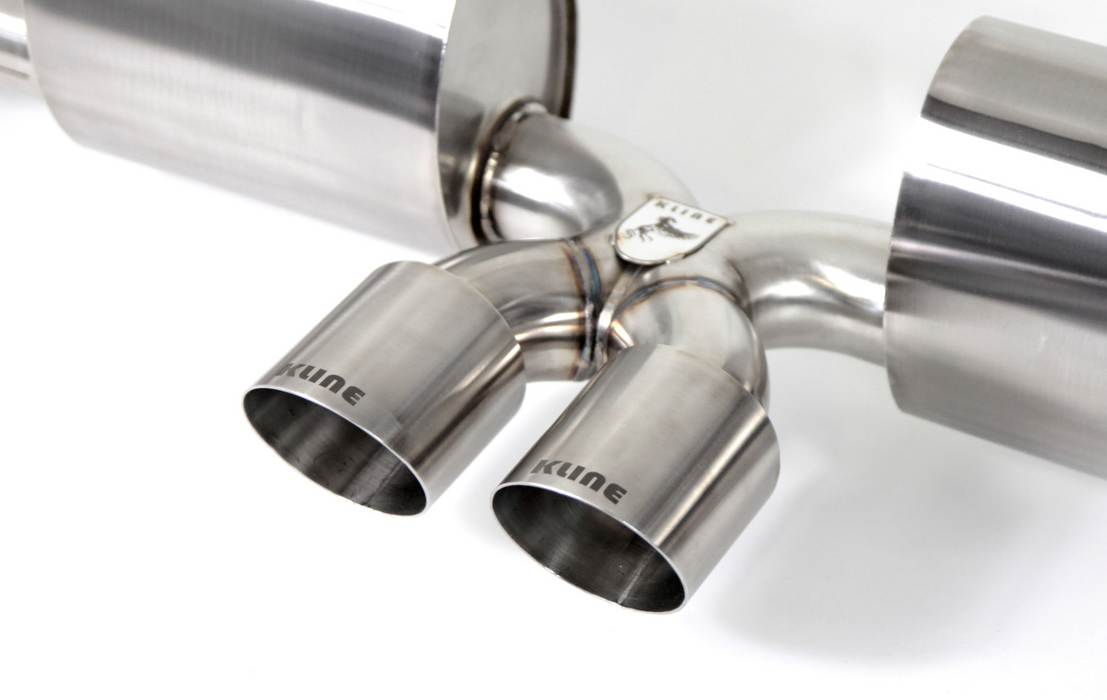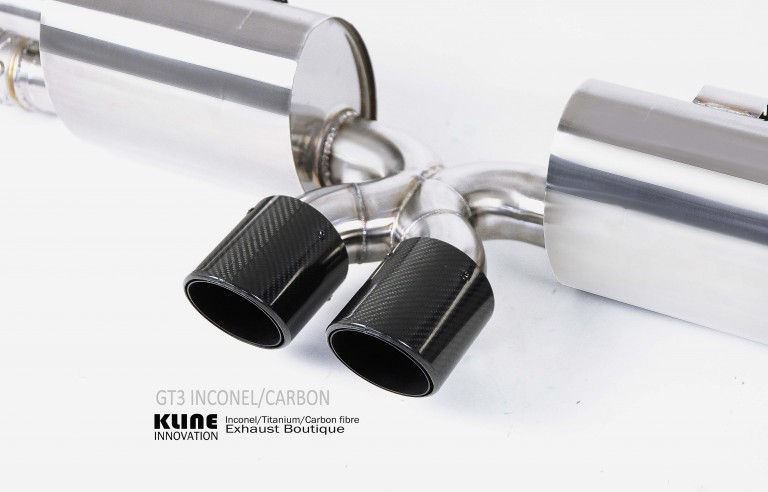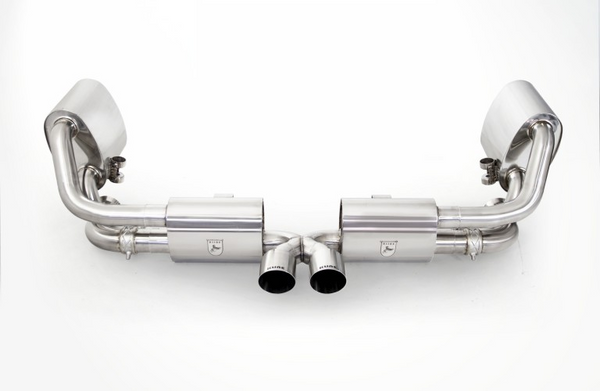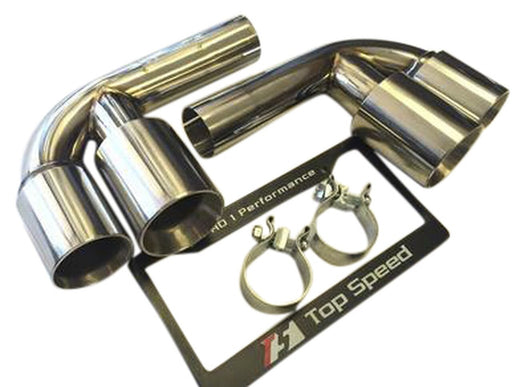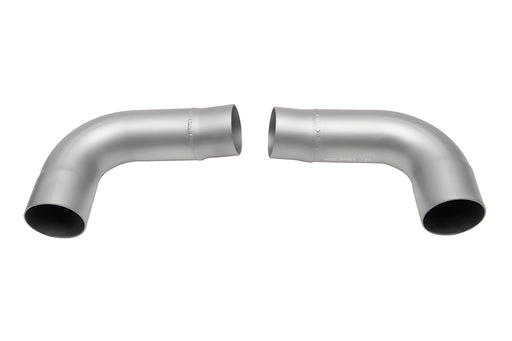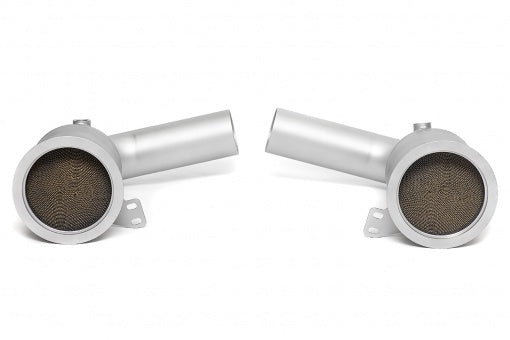Kline Innovation Valvetronic Exhaust System (991 GT3)
Designed to fit
- 2014 - 2016 Porsche 911 GT3 / GT3 RS (991.1)
- 2017 - 2019 Porsche 911 GT3 / GT3 RS (991.2)
Note - Kline Innovation GT3 Headers Sold Separately
Product Details
Capitalizing on a formidable heritage of race bred 911's. Upwards of 475 hp, and a 9000rpm redline, We wanted to make the exhaust scream like a racecar should! Applying our usual formula, F1 grade Inconel 625, tuned cross sections, and perfect X pipe geometry, we were able to craft an exhaust that not only has the perfect sound, but is lightweight, durable, and performs to the highest expectations.
Starting at the manifolds, replacing the stock cats for our 100 cell, or long tube catless Inconel headers opens up the sound significantly. The gases are then passed through one of 2 channels. On valve closed, the gases pass through our harmonically tuned, and internally ceramic insulated wing silencers to remove unwanted drone during highway cruising, and into the center muffler, and finally our trademark 1D CLR x pipe, this setup keeps the car very civilised when you want it to be.
On valve open The wing and center silencers are completely bypassed, allowing the gasses to pass freely through the exhaust system. The geometry of the Kline 1D CLR X pipe raises the pitch of the exhaust significantly into a raucous, yet beautiful, incendiary scream, without causing any restriction to the gas transit. The material Inconel 625 also has a unique sound, further enhancing the natural characteristic sound of the kline system. The sidewall is very thin, and resonates to produce an even higher pitched scream at high revs.
The largest performance gain comes from replacing the catalysts in the stock headers. The Kline headers and full system are designed to work in conjunction with each other for optimum performance and sound. The Kline system and headers are available in 2 options, 100 cpsi catalysts producing a largest gain of 18 hp and 27nm, or decat long tube headers producing a largest gain of 24hp and 35nm.
All cross section have been selected for a balance of peak torque and power
Manifolds
Primaries 51mm
Secondaries 70mm
Rear section
valve open, tapered 70mm into 63.5mm Xpipe
valve closed, 57mm into wing silencers
Tips
choice of 89 mm or 1o1mm, double walled inconel
or Carbon fiber
MATERIALS
Inconel 625, Manifolds decat 2.3kg each, wing silencers 4.6kg each, center silencer with tips 5.9kg each.
Total weight manifold back, 15.1kg,
Total weight Inc manifolds 19.7kg
19.2kg weight saving
304 grade stainless, Manifolds 4kg each, wing silencers 8.5kg each, center silencer with tips 10.5kg
Total weight manifold back 27.5kg
Total weight Inc manifolds 35.5
BUILD TIME
INCONEL 625
Manifolds 30 hours
Cat back, 35 hours
65 hours total
304 STAINLESS
Manifolds 18 hours
cat back 24 hours
42 hours total
Video
About Kline Innovation

Kline Innovation is a Bucharest, Romania based exotic exhaust manufacturer who utilizes exotic materials to innovate high-end systems for Porsche, Ferrari, Lamborghini, Aston Martin, Audi, Bentley and McLaren. At Kline they take exhaust design very seriously. Consumers demand a no compromise product, and they take a no compromise approach to design and manufacture.
MATERIALS
At Kline Innovation they believe in the absolute best materials for every application, chosen scientifically by the materials natural properties. Titanium/Inconel/Carbon fiber exhaust boutique, they also offer 304 stainless steel as an alternative on their complete range. Every material has its own unique properties, and perfect application based on weight, strength, heat resistance, and chemical stability. Kline strives to craft some of the world’s best lightweight exhausts utilizing every innovation possible!
The following is a brief overview and explanation of the different materials they use, properties, and functions.
INCONEL
Inconel 625 is used in the aerospace industry where extremely durable and heat withstanding components are required. As an example, Inconel is used for the exhaust turbine blades in high performance jet engines. Inconel is used for the manufacture of formula one exhausts, and has also been used by some manufacturers on hypercar projects such as the Mcalren P1, Aston Martin 177, where lightness is a factor, and exhaust temperatures regularly exceed 1800 degrees fahrenheit.
The basic properties of Inconel are characterized by extremely high tensile strength, and extreme thermos-chemical stability. Due to the high tensile strength of Inconel (roughly the same strength to weight ratio as titanium), very thin sidewall material can be used, while still maintaining structural integrity, resulting in very light weight components that will not fatigue over time. The main drawbacks to using Inconel, is that it’s extremely difficult to machine and weld, and requires a high degree of skill and involves a time consuming processes. It’s also extremely expensive as a raw material.
TITANIUM
Titanium in its varying grades is commonly used in a variety of applications where strength to weight ratio is paramount. Very high tensile strength and low density mean that very light and strong components can be manufactured easily. Titanium is also relatively easy to machine and weld using standard engineering approaches. The main disadvantages to titanium, is the cost of material, and prolonged heat exposure exceeding 1100 degrees fahrenheit causes oxidation of the material, resulting in brittle components and potential breakages. For this reason titanium is best suited to cooler applications where strength and lightness is a factor.
STAINLESS 304
Stainless steel 304 grade has become the industry standard for exhaust manufacturing. It’s moderate strength, thermos-chemical stability, inexpensive, and easy to manufacture. 304 stainless can be used to build relatively inexpensive exhausts to a high standard of functionality and durability. The main drawback to stainless steel is the weight. Roughly the same density of steel, but reduced tensile strength, building high performance exhaust components from stainless can be limited. Also from the perspective of sound, the thick sidewall required from stainless, can produce a slightly dull lackluster sounding exhaust note when compared to the previously mentioned materials!
CARBON FIBER
Carbon fiber reinforced polymer has an extremely high tensile strength to weight ratio, surpassing that of all metals. Extremely light weight components can be molded to almost any shape. The main drawback to carbon fiber being, the material cost, the fatigue endurance limit is hard to define (the material can break unexpectedly), and the lack of prolonged heat resistance due to the polymer binding agent.

